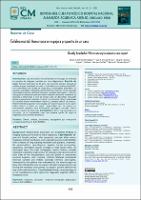| dc.contributor.author | Dávila hernández, Carlos Alberto | |
| dc.contributor.author | Arriola Torres, Luis Fernando | |
| dc.contributor.author | Moreno Legua, Jorge Eduardo | |
| dc.contributor.author | Carrasco Farfan, Carlos Andres | |
| dc.contributor.author | Camara Reyes, Ramon Rolando | |
| dc.date.accessioned | 2023-05-25T17:48:02Z | |
| dc.date.available | 2023-05-25T17:48:02Z | |
| dc.date.issued | 2022-10-10 | |
| dc.identifier.citation | Revista del Cuerpo Médico Hospital Nacional Almanzor Aguinaga Asenjo. 2022:15(3). | es_PE |
| dc.identifier.issn | 2227-4731 | |
| dc.identifier.uri | https://hdl.handle.net/20.500.12959/3715 | |
| dc.description.abstract | Introducción: Los aneurismas intracerebrales son hallazgos incidentales en estudios de imágenes realizado por otros diagnósticos. Reporte de Caso: Paciente femenino de 35 años, que presentó sincope después de cefalea de gran intensidad sin ceder a tratamiento convencional de AINES; con antecedente de cefalea de larga data y tratamiento esporádico. Al examen: neurológico: despierta, asimetría facial, disartria, fuerza muscular disminuida en ambos miembros inferiores, no signos meníngeos; el informe tomográfico cerebral sin contraste indicó: lesiones cerebrales expansivas de etiología a determinar a nivel de ambos lados de diencéfalo: descartar glioma vs aneurismas; Angiotac cerebral con contraste, refleja aneurismas de carótida interna intracraneal bilateral y cerebral media (en espejo). Posteriormente la paciente fue evaluada por neurocirujano de turno, quien indica referir a centro de mayor complejidad, por no contar con instrumental necesario para intervención quirúrgica; paciente fallece camino a centro de referencia. Conclusiones: Al ser una patología poco frecuente, no es considerada como una primera opción de sospecha diagnostica tras un evento de cefalea. | es_PE |
| dc.description.abstract | Background: Intracerebral aneurysms are incidental findings in
imaging studies performed for other diagnoses. Case Report: 35-
year-old female patient, who presented syncope after severe
headache without yielding to conventional treatment with NSAIDs;
with a history of long-standing headache and sporadic treatment.
On examination: neurological: awake, facial asymmetry,
dysarthria, decreased muscle strength in both lower limbs, no
meningeal signs; the brain tomographic report without contrast
indicated: expansive brain lesions of etiology to be determined at
both sides of the diencephalon: rule out glioma vs aneurysms;
cerebral Angiotac with contrast, reflects bilateral intracranial
internal carotid and middle cerebral (mirror) aneurysms.
Subsequently the patient was evaluated by the neurosurgeon on
duty, who indicated to refer to a center of higher complexity, for not
having the necessary instruments for surgery; patient died on the
way to the referral center. Conclusions: Being a rare pathology, it
is not considered as a first option for diagnostic suspicion after a
headache event. | es_PE |
| dc.format | application/pdf | es_PE |
| dc.language.iso | spa | es_PE |
| dc.publisher | Seguro Social de Salud (EsSalud) | es_PE |
| dc.relation.uri | http://cmhnaaa.org.pe/ojs/index.php/rcmhnaaa/article/view/1375 | es_PE |
| dc.rights | info:eu-repo/semantics/openAccess | es_PE |
| dc.rights.uri | https://creativecommons.org/licenses/by-nc-sa/4.0/ | es_PE |
| dc.subject | Cefalea | es_PE |
| dc.subject | Aneurisma | es_PE |
| dc.subject | Angiografía por tomografía computarizada | es_PE |
| dc.subject | Aneurisma intracraneal | es_PE |
| dc.subject | Neurocirugía | es_PE |
| dc.subject | Headache | es_PE |
| dc.subject | Aneurysm | es_PE |
| dc.subject | Computed tomography angiography | es_PE |
| dc.title | Cefalea mortal: Aneurisma en espejo a propósito de un caso | es_PE |
| dc.title.alternative | Deadly headache: Mirror aneurysm about a case report | es_PE |
| dc.type | info:eu-repo/semantics/article | es_PE |
| dc.subject.ocde | https://purl.org/pe-repo/ocde/ford#3.02.25 | es_PE |
| dc.identifier.doi | https://doi.org/10.35434/rcmhnaaa.2022.153.1375 | |






